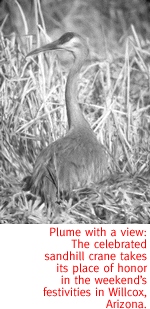
The Wings Over Willcox Festival Is In Full Flight.
By Kevin Franklin
THOUSANDS UPON THOUSANDS of sandhill cranes are descending
on Willcox and the Sulphur Springs Valley, which means it's time
for the fifth-annual Wings Over Willcox festival.
This year is shaping up to be one of the best years for the festival.
More than 21,000 cranes have come to winter in the area; that's
nearly twice the average mid-winter count, says Ron Olding, Arizona
Game and Fish Department regional wildlife program manager.
 On top of that, Wings Over Willcox program chairman Bob Coder
says the Willcox Chamber of Commerce will continue to expand its
programs during the weekend.
On top of that, Wings Over Willcox program chairman Bob Coder
says the Willcox Chamber of Commerce will continue to expand its
programs during the weekend.
"We have a lot more going on than just the cranes,"
he says.
This year's schedule includes seminars on birding, sky islands,
grasslands, bats and even the condor release program going on
in northern Arizona. There are also tours covering the geology
and history of the area, including a walking tour of Fort Bowie,
the staging area for General Nelson Miles' campaign against Cochise,
the legendary Apache chief.
On average, 45 bird species can be seen in the Sulphur Springs
Valley, and numerous tours during the festival will take people
to view them. The area is known in particular for its raptors,
including golden eagles, bald eagles, red tail hawks, ferruginous
hawks, American kestrels and peregrine falcons.
Because of the standing water in and around Willcox, a number
of waterfowl and wading species also come to the area. Combine
that with birds from the surrounding grasslands and mountains,
and it creates a birding Mecca.
Of course, center stage belongs to the mighty sandhills. One
of the tallest birds in North America at nearly four feet (the
exceedingly rare whooping crane is the tallest at 50 inches),
20,000 cranes make for a sight not soon forgotten. But more than
the visual impact, the sound of these vast flocks stuns most people.
Witnessing a morning flight, while thousands of cranes trumpet
a chorus at sunrise, stands as one of the great phenomena of the
natural world.
Sandhill cranes boast a wingspan of up to seven feet. Gray with
a red crown, the striking sandhills winter here and breed during
summer in Canada and Alaska. A few even venture all the way to
Siberia, Olding says.
 There are two primary factors that draw the cranes to this area.
First, they require shallow standing water, which can be found
in parts of Willcox Playa. When the cranes roost at night, they
stand in the middle of shallow pools or lakes in order to avoid
being eaten by coyotes, bobcats and the like. While able predators,
bobcats and coyotes cannot approach the roosting birds undetected
if they're out in these pools. Second, the cranes come to southeastern
Arizona in order to feed on the debris left after farmers in the
area harvest their various crops, especially corn.
There are two primary factors that draw the cranes to this area.
First, they require shallow standing water, which can be found
in parts of Willcox Playa. When the cranes roost at night, they
stand in the middle of shallow pools or lakes in order to avoid
being eaten by coyotes, bobcats and the like. While able predators,
bobcats and coyotes cannot approach the roosting birds undetected
if they're out in these pools. Second, the cranes come to southeastern
Arizona in order to feed on the debris left after farmers in the
area harvest their various crops, especially corn.
"They're interesting birds in a lot of ways," Olding
says. "They're extremely slow-producing, long-lived birds.
Their habit of roosting with their feet in just a couple inches
of water makes them kind of unique. Our country, as xeric (desert-like)
as it is, makes them susceptible to not having correct habitat.
That's one of the reasons we're working pretty hard on trying
to make sure they have adequate and secure roosting areas down
here."
The migration of these birds causes another migration, one of
eco-tourists to Willcox.
"In the previous year we had 400 to 450 people come out,"
Coder says. "For a little town that's a lot of people all
of a sudden. Some of the restaurant people say it's almost as
good a weekend as the Rex Allen weekend."
Biologists from a host of different agencies--including U.S.
Forest Service, Arizona Game and Fish, and the Bureau of Land
Management--are volunteering their time to lead the tours during
the weekend, says Diane Drobka, BLM Safford Office spokeswoman.
Pre-registration for the tours is over, but folks driving to
Willcox can generally expect to get on one of the tours, especially
those running with greater frequency.
"Some of the tours--like Lake Cochise--will be a lot easier
to get on. It depends on the tour. If people came and all the
tours were filled up, which is unlikely, there's plenty of things
to do on your own," Drobka says.
Getting There
Willcox is about 80 miles east of Tucson, off Interstate 10.
Tours and seminars begin at the Willcox Community Center
at 312 W. Stewart St. Call 1-800-200-2272 for more information.

|





